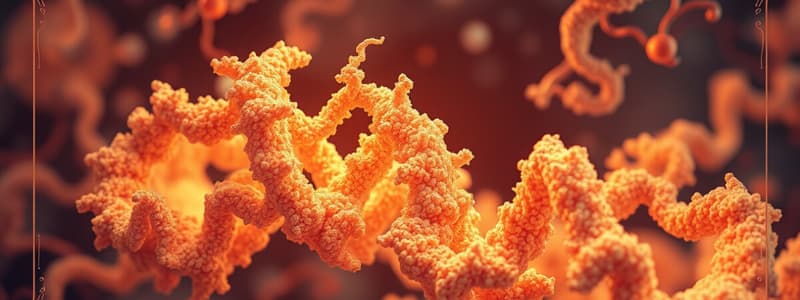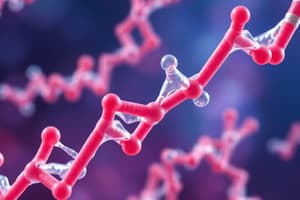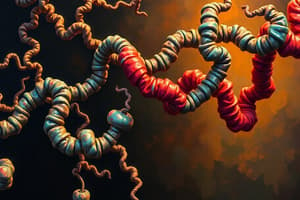Podcast
Questions and Answers
Most enzymes are what type of macromolecule?
Most enzymes are what type of macromolecule?
Protein
Most enzymes are what two structures?
Most enzymes are what two structures?
- Primary and Secondary
- Tertiary and Quaternary (correct)
- Linear and Circular
- Simple and Complex
Enzymes act as what in reactions?
Enzymes act as what in reactions?
catalysts
Are enzymes permanently changed in the chemical reactions they are involved in?
Are enzymes permanently changed in the chemical reactions they are involved in?
Will an enzyme work on any substance?
Will an enzyme work on any substance?
Can enzymes be reused?
Can enzymes be reused?
What ending is found on many enzymes?
What ending is found on many enzymes?
What are 3 examples of enzymes with this ending?
What are 3 examples of enzymes with this ending?
How does an enzyme work?
How does an enzyme work?
What effect does an enzyme have on the activation energy needed to start a reaction?
What effect does an enzyme have on the activation energy needed to start a reaction?
Hydrogen peroxide (H2O2) is a common waste product of cells. Enzymes called catalases in cells break this down into harmless what?
Hydrogen peroxide (H2O2) is a common waste product of cells. Enzymes called catalases in cells break this down into harmless what?
What is meant by the term substrate?
What is meant by the term substrate?
What is meant by an active site?
What is meant by an active site?
What is meant by induced fit?
What is meant by induced fit?
What induces an enzyme to change the shape of its active site?
What induces an enzyme to change the shape of its active site?
List 4 factors that can affect enzyme activity.
List 4 factors that can affect enzyme activity.
What is the effect of high temperature on an enzyme?
What is the effect of high temperature on an enzyme?
What temperature do most enzymes do best at?
What temperature do most enzymes do best at?
Most enzymes like a pH near?
Most enzymes like a pH near?
To denature an enzyme means the enzyme becomes what and can no longer work properly?
To denature an enzyme means the enzyme becomes what and can no longer work properly?
What type of molecule is this and identify the type of saccharine it is: Sucrose, disaccharide?
What type of molecule is this and identify the type of saccharine it is: Sucrose, disaccharide?
What are glucose, fructose, and sucrose?
What are glucose, fructose, and sucrose?
What molecule is this and how many water molecules will come from this: Cellulose?
What molecule is this and how many water molecules will come from this: Cellulose?
What molecule, what macromolecule, and what type of molecule is glucose?
What molecule, what macromolecule, and what type of molecule is glucose?
What are 2 types of storage molecular structures?
What are 2 types of storage molecular structures?
What are 2 types of structural molecular structures?
What are 2 types of structural molecular structures?
What is the following molecule: triglyceride?
What is the following molecule: triglyceride?
What is the difference between the molecular structure of a saturated and unsaturated fat?
What is the difference between the molecular structure of a saturated and unsaturated fat?
What is the following molecule: steroid?
What is the following molecule: steroid?
What group of macromolecules are estrogen and cholesterol?
What group of macromolecules are estrogen and cholesterol?
What is dehydration?
What is dehydration?
Flashcards are hidden until you start studying
Study Notes
Proteins and Enzymes
- Proteins are the most common macromolecules that function as enzymes.
- Enzymes typically exhibit tertiary or quaternary structural formations.
- Enzymes act as catalysts, accelerating chemical reactions without being consumed.
- Enzymes are not permanently changed in the chemical reactions they facilitate.
- Enzymes are specific and will not work on just any substrate.
- Enzymes can be reused multiple times in different reactions.
- Many enzyme names end with the suffix "ase."
Examples and Functionality of Enzymes
- Common examples of enzymes include sucrase, lactase, and maltase.
- Enzymes weaken bonds to lower activation energy, making reactions easier to occur.
Activation Energy
- Enzymes lower the activation energy required to initiate chemical reactions.
Substrates and Active Sites
- The term substrate refers to a reactant in an enzyme-catalyzed reaction.
- The active site is the specific region of an enzyme that binds substrates and facilitates reactions.
- Induced fit describes the conformational change an enzyme undergoes to effectively bind to its substrate.
Factors Affecting Enzyme Activity
- Factors influencing enzyme activity include:
- Environmental conditions (temperature, pH)
- Co-factors and co-enzymes
- Inhibitors
Temperature and pH
- High temperatures can denature enzymes, impairing their function.
- Most enzymes function optimally at around 98.6°F.
- An ideal pH range for most enzymes is between pH 6 to 8.
Effects of Denaturation
- Denaturation results in enzymes becoming unfolded, rendering them inactive.
Carbohydrates and Molecular Structures
- Sucrose is a disaccharide, a type of carbohydrate molecule.
- Glucose, fructose, and sucrose are simple sugars that create energy sources.
- Cellulose is a polysaccharide; three water molecules are released during its formation.
- Glucose is classified as a carbohydrate and a monosaccharide.
Storage and Structural Molecules
- Two types of storage macromolecules include lipids and carbohydrates.
- Proteins and chitin serve as structural macromolecules.
Lipid Structure
- Triglycerides are a specific type of lipid.
- Unsaturated fats contain one or more double bonds between carbon atoms, distinguishing them from saturated fats.
Steroids
- Steroids are a class of lipids, including hormones like estrogen and cholesterol.
Biological Processes
- Dehydration refers to the removal of water from a molecule, crucial in forming larger macromolecules.
Studying That Suits You
Use AI to generate personalized quizzes and flashcards to suit your learning preferences.





